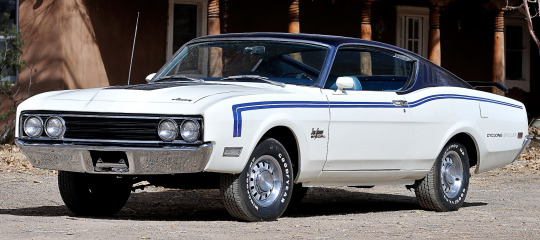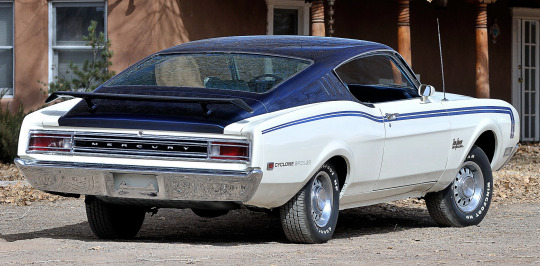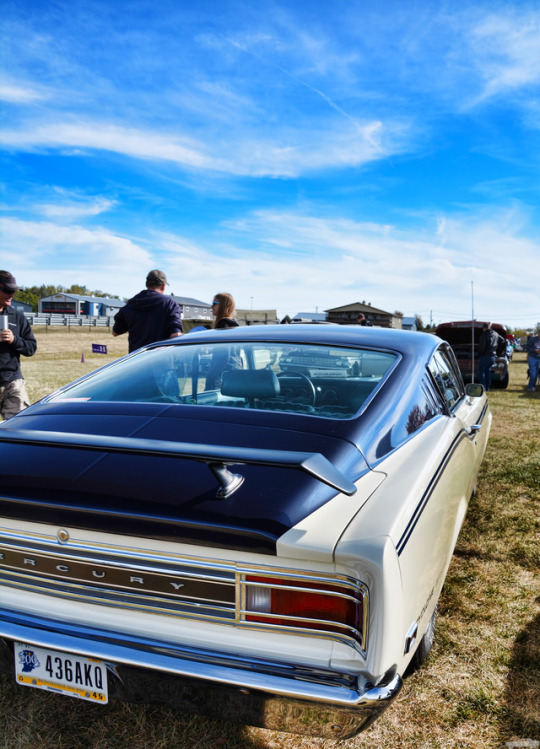#Mercury Cyclone Spoiler Dan Gurney Special
Explore tagged Tumblr posts
Text

Mercury Cyclone Spoiler Dan Gurney Special, 1969. For reference, this is a (less aerodynamic) "W nose" version of the Cyclone Spoiler (see previous post)
#Mercury#Mercury Cyclone Spoiler#Mercury Cyclone Spoiler Dan Gurney Special#Dan Gurney Special#1969#homologation#W nose#NASCAR#dead brands#pillarless hardtop
195 notes
·
View notes
Text

142 notes
·
View notes
Text

Mercury Monday; '69 Cyclone Spoiler "Dan Gurney Special"
146 notes
·
View notes
Video
youtube
1 of 11! 1969 Mercury Cyclone Spoiler II Dan Gurney Special, M code 351...
0 notes
Photo





1969 Mercury Cyclone Spoiler Dan Gurney Special
42 notes
·
View notes
Text
Cougars Prowl Dearborn for 50th Anniversary Celebration
For all the national and regional events marking the Mercury Cougar’s 50th anniversary in 2017, we will go out on a limb and suggest that none quite compares to the June event presented by the Cougar Club of America and the CATS Cougar club.
Hosted in the shadow of the “Glass House,” on the grounds of Ford’s world headquarters in Dearborn, the event not only attracted the largest collection of Cougars we have ever seen but drew some of the most significant cars from far-flung corners of the U.S. and Canada. From the Detroit Historical Society, only a few miles away, came the original Cougar II concept that Ford showed at the 1964 World’s Fair, while from the Seattle area Jim and Elaine Pinkerton brought production-model number 001, a car built on July 4, 1966.
And then there was the colorful column of Competition-painted Eliminator models and, more specifically, the record assemblage of Boss 302-powered examples. Only 637 were built (169 in 1969, 468 in 1970), and 10 of them were on the ground in Dearborn. To the Cougar cognoscenti on hand, no one could recall seeing more in one place. It was an impressive display to behold regardless of your muscle car brand loyalties.
Among the rarest of the Boss Cats was Eric Petosa’s 1970 Lime Green Metallic car, which he purchased in 2000 and spent several years restoring. The original owner, Henry Brenninman, ordered it with steel wheels and hubcaps rather than the typical styled-steel wheels, as well as a special green interior. It wasn’t on the order sheet for the Eliminator, but Brenninman got it done. He also persuaded the factory to leave off the unique rear spoiler, which was delivered in the trunk.
Petosa believes it was the last Cougar Eliminator built, and he invited Brenninman to Dearborn to mark the occasion.
“It’s such a unique car in so many ways,” says Petosa. “It’s been a real thrill to own and restore it, and it was very special for Henry to travel here from Washington to share the story.”
That sentiment encapsulates much of what we heard from other enthusiasts, whose stories and experiences often date back decades. Not all of them were forged in the classic first-generation models, either. Plenty of owners were representing the middle and later years of the Cougar’s history. There were eight generations in all, ranging from the Mustang-based first generation to the extra-large, Thunderbird-based models of the late 1970s to the front-drive eighth generation that was based on the Ford Contour architecture.
Not surprisingly, the first-generation models composed the majority of the approximately 130 cars at Dearborn. With their chiseled lines, hidden headlamps, sequential turn signals, and other distinguishing features, there was always more to the Cougar than it being simply a reskinned Mustang—and they continue to distinguish the car half a century later.
Photo courtesy Ford Motor Co.
10 Fast Facts About the Mercury Cougar
1. Cougar was very nearly the name of the Mustang. Design models as late as mid-1963 showed that name and a cat emblem within the iconic grille “corral.” 2. Although based on the Mustang, the first-generation Cougar’s 111-inch wheelbase was 3 inches longer than its corporate cousin. 3. Vacuum leaks in the retractable headlamp door system of first-generation models can affect engine performance, causing idling problems, reduced horsepower, and higher fuel consumption. 4. The name Eliminator was first used on the 1968 Funny Car campaigned by Dyno Don Nicholson. 5. Drag racers Dyno Don Nicholson and Eddie Schartman were reportedly the recipients of two Cougars built by Kar Kraft with Boss 429 engines. 6. Mercury built a Cougar concept in 1970 called El Gato (Spanish for The Cat). It experimented with fastback styling, sort of like a Cyclone. It also sported centrally located, rectangular exhaust outlets, much like the 1969-1970 Shelby Mustangs. 7. A 1973 Cougar was the last factory convertible built by Ford until the 1983 Mustang convertible was introduced. 8. Cougar production peaked in 1978, at 213,270. 9. Cougar station wagons were offered in 1977 and 1982. 10. Approximately 5,000 20th Anniversary models were built in 1987, each with exterior trim finished in real 24-carat gold.
This is the Cougar II, one of three “X-Car” concepts developed by Ford in the early 1960s. The others included the Cougar I (also known as the Cougar 406), featuring gullwing doors, and the Bordinat Cobra roadster, named for Ford’s chief stylist, Eugene Bordinat. The roadster and the Cougar II were built on Cobra chassis, with the Cougar II powered by a 260 small-block. Ford showed it with the Mustang II concept at the 1964 World’s Fair. It is currently part of the Detroit Historical Society’s impressive auto collection.
Eric Petosa’s 1970 Lime Green Metallic Boss 302 Eliminator is probably the most well-documented Eliminator out there. It is as unique as they come, with factory steel wheels and hubcaps as well as a custom-ordered green interior, which wasn’t part of the Eliminator’s factory palette. Petosa has owned the car since 2000 and subjected it to an incredibly thorough restoration.
Eric Petosa, left, stands with Henry Brenninman, who was the original owner of Petosa’s Lime Green Metallic Boss 302 Eliminator. Brenninman ordered the car without the Eliminator’s signature rear spoiler installed (the car was delivered with the spoiler in the trunk). He also had the dealership install a vinyl roof. Petosa invited Brenninman to the Cougar show and the two met for the first time there.
Jim and Elaine Pinkerton came all the way from the Seattle area to show their milestone 1967 Cougar, serial number 0001. It was built July 4, 1966. While it was not badged a GT, it has all the equipment, including the 320hp 390 four-barrel Marauder engine. Turns out the GT performance package hadn’t yet been approved when the car was built.
Mike Sajdek’s 302-powered 1968 XR7 looks fresh off the rotisserie, but the 38,000-mile Cougar is in original condition. Originally ordered by a woman who rarely drove it, she traded it in 10 years later, and the dealership held onto it for years, preserving it. A subsequent owner did so well with it in “original” categories at events that he was asked to stop showing it. Sajdek shows it once or twice a year, continuing its remarkable preservation.
Pioneering racer Fast Eddie Schartman, who won NHRA’s first-ever Funny Car Eliminator trophy in 1966, shook up the sport with the Cammer-powered Air Lift Rattler Cougar Funny Car a couple years later. He won the AHRA Winternationals in it. It was also immortalized on the cover of Super Stock and Drag Illustrated and was offered in reduced scale as a model kit.
Tom Wilds’ Competition Gold 1970 Eliminator was another stunner from the record assemblage of 10 Boss 302 cars at the event. The Boss 302 engine added $388 to the cost, along with another $204 for the Hurst-shifted four-speed transmission, for a nearly $600 premium on a car that would otherwise sticker for around $3,400. This one totaled nearly $4,300.
A surprisingly strong contingent of Canadian Cougar owners made the trek to Dearborn, including Ron and Liz Brazeau, who brought this clean, impeccably straight 1967 289-powered XR7. It was the Cougar’s best-selling year of the first generation, recording more than 150,000 sales, including more than 27,000 XR7 models.
We didn’t get the backstory on this Trans-Am tribute car, but from the Cougar and Bud Moore graphics to the period racing wheels and all-business interior, it was a well-done nod to the couple of years when such racers as Parnelli Jones and Dan Gurney challenged even the corporate-cousin Mustangs on North American road courses.
The 428 Cobra Jet engine was offered in the 1969 Cougar, and that’s just what’s under the hood of Jim Demmer’s XR7. Ford crafted the Cobra Jet with 427 “low riser” cylinder heads, an iron version of the Police Interceptor intake manifold, a high-lift hydraulic camshaft, and a Holley four-barrel. To ward off the insurance companies, the horsepower rating was sandbagged at 335, but it really produced more than 400.
There’s a houndstooth-pattern vinyl top on Bernie Schweigman’s 1970 Cougar XR7, along with a complementary houndstooth interior. Both were factory options originally ordered on the car. It was offered in a brown-checked pattern or the black version seen here. Exact figures are hard to come by, but the production numbers for this feature are likely less than 500.
Another unique race car on hand was the Boss 429-powered Cougar campaigned by Dyno Don Nicholson and owned today by Ed Myer. The Shotgun engine apparently didn’t work so well in the Cougar, as the car was too heavy to be competitive. Nicholson eventually swapped the Boss ’9 engine for a 427 Cammer, and that’s what’s currently under the hood.
Californian Rob Crowder came to Dearborn to show this 1968 Cougar XR7-G. The G stood for Gurney, as in racer Dan Gurney, who inspired the European-flavored special model. Content included a unique hoodscoop and other exterior and interior enhancements. The conversions to G-spec were done by A.O. Smith, in Ionia, Michigan, at the same facility where Shelby Mustangs were built. There were 619 XR7-G models built, including 431 with power sunroofs. Lincoln-Mercury also sent to 188 of them to Hertz Rent-A-Car.
Darren LaLonde’s 1968 302-powered XR7 coupe features an original power sunroof. A little more than a thousand cars that year were built with one, including 431 XR7-G models and reportedly only 265 “regular” XR7s. American Sunroof Corporation installed the sunroofs (featuring Bosch mechanicals) away from the Dearborn plant and also handled the complementing vinyl roof installation.
Representing the later years of Cougar’s history, local enthusiast and original owner Ralph Boyer showed his showroom-clean 1990 XR7, which featured that same 210hp supercharged V-6 engine that powered the Thunderbird Super Coupe. Performance was competitive for its day, with 0-60 sprints in about 7.5 seconds and quarter-mile times of about 16 seconds.
Another of the Boss 302 Eliminator cars on display was Dave Wyrwas’ Competition Blue 1970 model. This Cougar still has its original drivetrain, including the factory-ordered Super Drag Pack content, which included an oil cooler and a 4.30 axle ratio for the Detroit Locker differential. Wyrwas runs the Cougar Eliminator Registry, eliminator.mercurycougarregistry.com.
Sold originally in Midland, Texas, Rob Merritt’s Minnesota-based 1969 Cougar XR7 convertible is one of 46 built with the 428 Cobra Jet (non-ram air) engine. It is also one of one in Dark Ivy Green with white bucket seats. It has a C6 automatic transmission, a 3.25-geared Traction Lok axle, and, not surprisingly for its original home in Texas, air conditioning.
Another supercar Cobra Jet Cougar convertible was shown by Arid Thu of British Columbia. Breaking down the numbers reveals that the beautifully restored cat is one of only 31 Cobra Jet ram-air cars with a four-speed.
Despite growing into luxo-barge territory by the mid-1970s, the Cougar enjoyed its best sales year to date in 1977, with a tick fewer than 195,000 sold. Terry Glime’s 1977 XR7 is one of the best of the surviving bunch, with 36,000 original miles. Cougar sales peaked in 1978, at more than 213,000. That was a lot of cats!
Quick Cougar Eliminator validation fact: The pedestal-mounted rear spoiler was so heavy that the trunk lid required its own prop rod to hold it open. You won’t find it on other Cougar models.
The post Cougars Prowl Dearborn for 50th Anniversary Celebration appeared first on Hot Rod Network.
from Hot Rod Network http://www.hotrod.com/articles/cougars-prowl-dearborn-50th-anniversary-celebration/ via IFTTT
0 notes
Text




Mercury Cyclone Spoiler II Dan Gurney Special, 1969. A homologation special that allowed Mercury to compete in NASCAR stock car racing. To make the car more aerodynamic, a sleeker front section was used. The nose was replaced with one that extended the car's length and a flush-mounted grille from a Ford Cobra was fitted. The front bumper was actually a rear bumper off a 1969 Ford Fairlane that was cut, narrowed, and filled on the ends. Homologation rules meant 500 road-going cars needed to be made but only 351 "flat nose" examples were built, all with the 351ci Windsor V8 engine and automatic transmission. To make up the 500 a further 152 "W nose" Cyclone Spoilers were created with a variety of engine and transmission combinations, making 503 Dan Gurney Special models in all.
NASCAR needed to verify that 500 cars were made (during the first few weeks of 1969): As the story goes they built 351 extended "D" nosed cars; parked them in the front and on the edges of a parking lot; took 152 regular "W" nosed Cyclone Spoilers and parked them in the middle of all the Spoiler IIs in the parking lot. When NASCAR counted the cars they just never looked closely enough at the cars in the rear
#Mercury#Mercury Cyclone Spoiler II#Dan Gurney Special#homologation#special edition#flat nose#1969#351ci V8#Windsor V8#dead brands
232 notes
·
View notes
Photo

273 notes
·
View notes
Photo

102 notes
·
View notes
Photo




1969 Mercury Cyclone Spoiler Dan Gurney Special
#1969 Mercury Cyclone Spoiler Dan Gurney Special#CVMC Car Show 2017#Autobahn Country Club#Joliet#Illinois
10 notes
·
View notes
Photo


Cyclones
#1969 Mercury Cyclone Spoiler Dan Gurney Special#1969 Ford Ranchero#CVMC Car Show 2017#Autobahn Country Club#Joliet#Illinois
3 notes
·
View notes